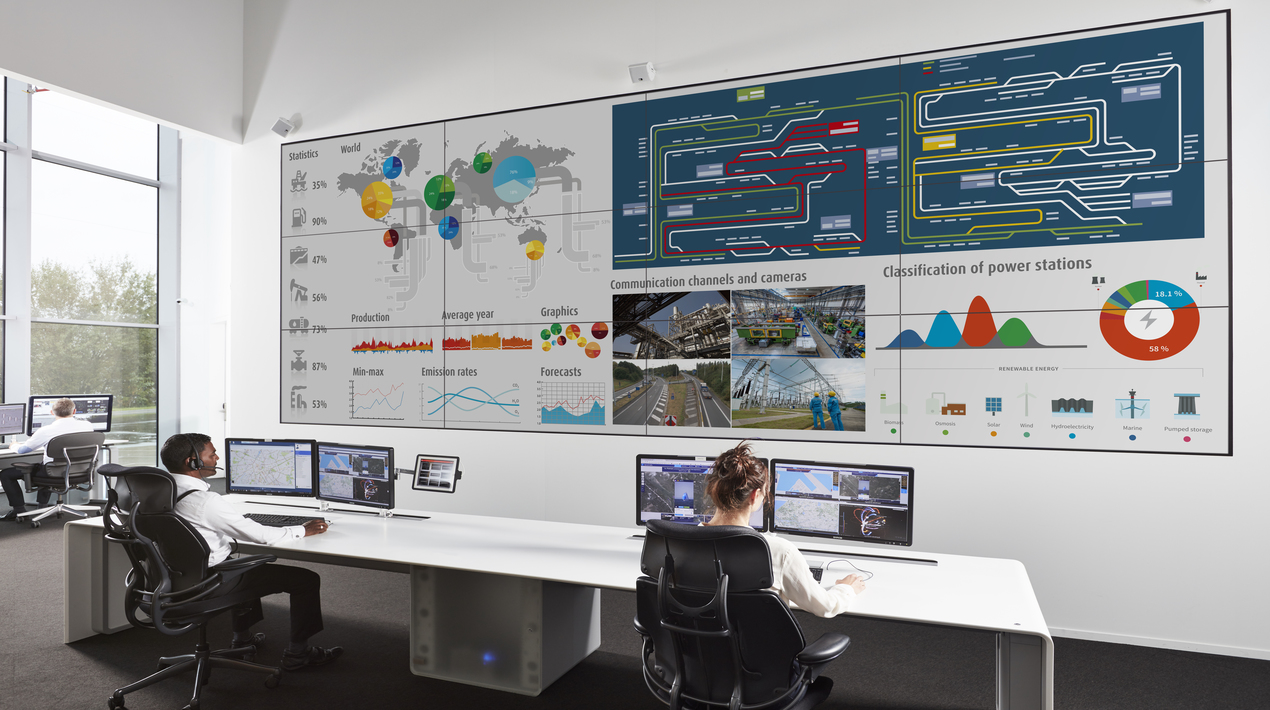
Every enterprise has one or more workflows that they need to monitor or control. These workflows can either be application-based such as surveillance and monitoring or process control, industry-based such as utilities, military, government, transportation, etc. Or even a hybrid of both bases. Some of those enterprises use a dedicated control room to do that: they either use large video walls (a common operational picture) or smaller operator workstations (personal operational pictures) to look at traffic camera streams, security videos, manufacturing processes, utility grids, maps, social media, or live news.
 The idea of having a control room appeals to a growing number of enterprises and industries. Among the unusual suspects are the healthcare and pharmaceutical industries, financial institutions, educational campuses, and many Fortune 500 corporations. But why do they need a control room? And could it be that you need one too?
The idea of having a control room appeals to a growing number of enterprises and industries. Among the unusual suspects are the healthcare and pharmaceutical industries, financial institutions, educational campuses, and many Fortune 500 corporations. But why do they need a control room? And could it be that you need one too?
Most of these enterprises have very good reasons why they organise their decision-making workflows in a control room. As for Barco-equipped control rooms, one security and surveillance customer study reported that they were able to speed up their decision-making process by a factor of 6. Another customer study reported a 30% increase in workflow productivity. Whether you are working for a private company or public organisation, those are outcomes that speak for themselves.
Why a control room?
Control rooms help to organise and improve workflows where decisions need to be made based on large amounts of (visual) data. This is the case in a utility centre, a traffic control centre, but just as well in a healthcare operations centre, a network operations centre, or a corporate risk management centre.
Does your company need a control room? That may depend on your workflow.
Let us look at some of the most typical workflows that can be supported by a control room: from human-centred viewing to machine-aided resolving.
- The common operational picture (COP): In this workflow, a team of operators or stakeholders is monitoring a single large overview display of relevant information. A common operational picture allows those stakeholders to achieve situational awareness. This workflow follows management by supervision principles and depends on achieving visual collaboration.
- Shared situational awareness: This is where you share your common operational picture with a different decision-making unit in the same facility (e.g. a break-out room or a situation room). This workflow follows management by escalation principles and depends on achieving hierarchical collaboration.
- Collaborative operational control: Here, operators and stakeholders interact directly with their content, through personal operator workspaces. They can select the content sources they want to see and share that content with others in the control room, to make joint decisions. This workflow follows management by exception principles and depends on achieving operational control.
- Distributed decision-making: This is a form of collaborative decision-making where information is shared outside the control room enterprise, for example with another agency. This workflow follows management by collaboration in its truest form and depends on achieving inter-agency teaming.
- Automated workflow optimisations: In automated workflows, decisions are learnt, aided, and even predicted by robots consisting of smart algorithms, machine learning, or artificial intelligence. This workflow follows management by automation principles and depends on achieving a machine-learning platform of finite-state and predictable-state automation on possible decisions, that either flag for a human-expert approval or is entrusted enough to authorise decisions up to a certain emergency level.
In this continuum from top to bottom, we see workflows becoming more complex, from centralised to distributed, from hierarchical to teaming-based, from management by supervision to management by exception, from hardware to software-based, and from manual to automated. The more you move to the right side of the spectrum, the smarter and faster decisions can be made. It is also important to mention that one or more of the above workflows can perfectly co-exist in any given operational environment.
If you see this spectrum of decision-making workflows, then the question ‘do I need a control room’ may translate into more specific questions like:
- Do I need to combine multiple content types and sources in one view to make decisions?
- Can the way my information is presented improve my decision-making?
- Do I need to be able to interact with the content or personalise my workspace?
- Does my content need to be shared among colleagues?
- Does my content need to be distributed to external stakeholders or agencies?
- Are the decisions I take on a day-to-day basis predictably similar in nature or unique each time?
A control room may not be typical for your industry, but if the answer to one or more of the above questions is ‘yes, then a control room might indeed improve your workflow.
Instead of asking yourself what common practice in your industry is, a better question may be: ‘What does my workflow look like today?’ and ‘Can I improve my workflow to achieve better outcomes for my enterprise?’ Of course, you do not know what you do not know. However, asking the above-mentioned questions may be a first step towards improving your decision-making workflows with a control room.
















